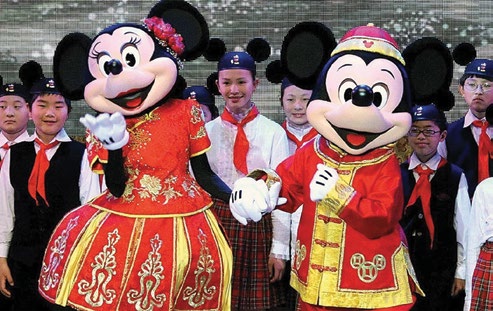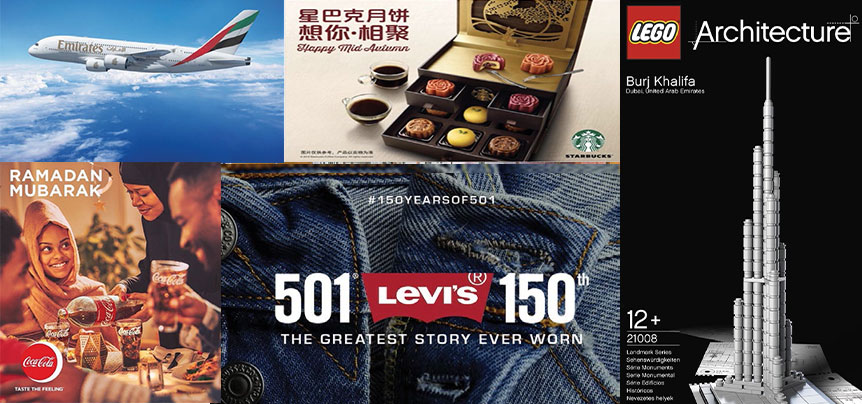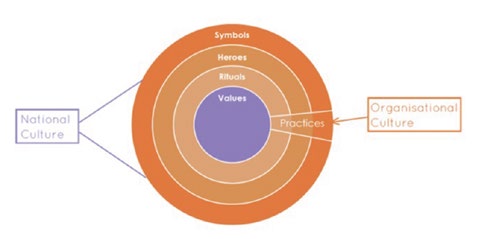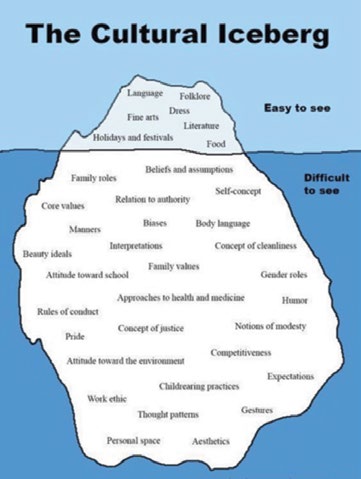Cultural Authenticity
A Strategic Approach to Brand Cultivation and Expansion
By Adeeb Alghoufary
Cultural Authenticity: A Strategic Approach to Brand Cultivation and Expansion
Executive Summary:
In this article, we explore the complex role of cultural authenticity in corporate branding and strategic brand management in the interconnected global landscape. The focus is on ways in which brands can represent the values, traditions, and history of culture authentically by moving beyond shared values to engage with the shared emotional preferences that reflect consumers’ deep-seated beliefs. This approach is key to creating branding that is culturally accurate and emotionally resonant and fosters sincerity and integrity in a space often characterized by superficial representations. We employ two theoretical frameworks, Hofstede’s onion model and Hall’s iceberg model, to demonstrate these cultural dynamics and their impact on authenticity. The key aspects integral to cultural authenticity in branding discussed here include: 1.Creating cultural awareness. A case studyof Emirates Airlines shows how brands canresonate with cultural norms and consumerhierarchy in contrast with companies such asFinnair that emphasize egalitarian values. Byintegrating traditional Emirati elements intoits brand, Emirates offers a culturally rich experience. 2.Defining culturally relevant products andspaces. Product design can embody culturalauthenticity, as Starbucks’ introduction of themooncake in Asia and Anghami’s delivery ofMiddle Eastern music culture demonstrate. 3.The global impact of local trends and content creation. Brands can both influence andbe influenced by cultural trends and consumer behaviors, prime examples being Disney’sstrategic localization in China and the globalimpact of South Korean K-pop culture. 4. Embracing feedback culture to drive innovation. Brands such as LEGO and Coca-Colaexemplify the importance of listening to cultural needs and user feedback for innovationand maintaining consumer trust. 5.Advocating purposeful and socially compliant principles and norms. The article concludes with a discussion of how brands canalign their universal appeal with local cultural nuances. Chanel and Patagonia serve as leading examples that global brands can manage to comply with social discourses. These brands not only provide customers with a sense of purpose but also showcase successfully how aligning social aspects and creating awareness on a global scale can accomplish business success. Overall, we stress that cultural authenticity is not a surface-level consideration but, rather, a fundamental aspect of strategic brand transformation and business development. Our examples demonstrate that this form of authenticity plays a key role in shaping brand perception and contributes to long-term sustainability. Thus, by embracing cultural authenticity, businesses can forge deep connections with their customers and operate effectively in diverse markets while maintaining their core identity.
Introduction:
In the contemporary interconnected world, there is increasing recognition of the significance of cultural authenticity in corporate branding activities and, by extension, strategic brand management. Culturally authentic branding emphasizes genuine and respectful representations of the values, traditions, and history in the countries and regions where products and services are marketed. Conceptually, cultural authenticity transcends surface-level shared values to focus instead on the shared emotional preferences that reflect customers’ core values. Doing so naturally requires a deep understanding of and reflection on the unique features of the culture of a brand’s customers. The focus on shared preferences ensures that branding is not simply consistent with the prevailing norms but emotionally resonant thereby fostering sincerity and integrity in a landscape often characterized by superficiality. By embracing cultural authenticity, companies create branding that genuinely connects with their diverse customer bases. We draw on two complementary theoretical frameworks, the onion model and the iceberg model, to explain the relationship between the multifaceted layers of cultural dynamics in and authenticity. 1.Geert Hofstede’s onion model serves to identify and categorize the various components ofcultures. From this perspective, culture is notmonolithic but rather consists of distinct layers, each of which influences behavior, values,and norms. The outer layer includes observable elements, such as clothing and symbols, whilecloser to the core are values and beliefs, all of which reflect fundamental assumptions. An understanding of each of these layers is crucial for assessing the authenticity of cultural expressions and distinguishing surface-level practices from basic values and worldviews. 2.Edward T. Hall’s icebergmodel complements the onion model with an emphasison the hidden aspects of culture. In this model, the tiprepresents the observable elements of culture, such as language, food, and gestures, while the much larger submerged portion represents the deeper, less visible aspects, such as communication styles, social norms, and unspoken rules. In the context of cultural authenticity,
this model underscores the fact that superficial observations are ineffective for achieving cultural understanding. Together, these models provide a comprehensive framework for examining and assessing cultural authenticity in the context of branding. Thus, the onion model serves to categorize cultural elements so as to distinguish superficial observations from genuine cultural values while the iceberg model highlights the need for a deep exploration of the often hidden factors that shape cultures. This dual framework facilitates meaningful and authentic appreciation of, respect for, and engagement with diverse cultures. The commonality between these models lies in their exploration of cultural layers and the recognition that there are aspects of culture not immediately visible. They highlight that deeper cultural dimensions significantly influence visible and explicit behaviors helping to understand and compare national and organizational cultures, providing insights into cross-cultural communication by revealing hidden and implicit cultural factors that may cause misunderstandings. Indicating cultural rules, acknowledged by both models, shape behavior, emphasizing the multifaceted nature of culture with visible manifestations and underlying layers that influence interactions. At the heart of cultural authenticity in branding is the commitment to foundational values and accurately representing and connecting with diverse cultures. This commitment fosters a brand experience that is emotionally rich, sincere, and reflective of the subtleties of various cultural identities. Approached this way, branding transcends aesthetics, symbols, heroes, and rituals to encompass the strategic process of crafting the identity, values, and narratives associated with products and services in ways that resonate genuinely with consumers. Culturally authentic branding, then, involves creating a distinct and memorable image of a brand that is in harmony with the cultural contexts in which it operates. An authentic brand identity builds on visual elements to encapsulate the inherent values and distinctive characteristics of consumers in a manner that resonates with them and engages with their emotional preferences so as to mirror a brand’s ethos and its consumers’ cultural and personal identities. Such heartfelt and genuine approaches elevate brand identity from simple imagery to a meaningful connection, thereby enriching and deepening consumers’ relationship with it. Here, we provide a nuanced perspective on cultural authenticity and the shaping of brand perceptions. Through carefully selected case studies, we investigate the role of cultural authenticity in effecting positive change across the increasingly diverse global landscape. Our analysis goes beyond traditional marketing strategies to examine the complex interplay between culture and brand identity. We cover the key considerations for crafting an authentic brand strategy and offer a lucid and thorough account of how cultural authenticity informs and molds the branding journey.

Aspect 1:
Creating Cultural Awareness Emirates, Dubai’s flagship airline, is emblematic of the city’s status as a global hub of high-end hospitality. The brand manifests the city’s love of luxury and its role as a cultural melting pot, as is readily apparent in first-class services designed meticulously to show deep respect for clients’ status. Emirates’ exclusive private suites, exquisite gourmet dining, and exceptional service cater to elite travelers’ desire for exclusivity and prestige. Hofstede’s cultural dimensions, particularly the power distance index (PDI), are enlightening in this context. The members of high-PDI societies that form a significant portion of Emirates’ market appreciate profound respect for hierarchy with first-class offerings customized to provide levels of service that recognize and reinforce the social standing of its target customers. By contrast, Finnair, a leading European airline company, is rooted in the low-PDI culture of Finland and, accordingly, prioritizes egalitarian values and functional simplicity with an approach to service, including in business class, that emphasizes efficiency, environmental mindfulness, and a consistent experience for all in a manner consistent with Finnish cultural values. Moreover, Emirates seamlessly incorporates distinct Emirati elements—including traditional architecture, clothing, Arabic calligraphy, henna art, camel and falcon culture, and the ambiance of traditional souks—into its brand identity. In this way, the brand has forged a rich cultural identity that marries traditional values with modern progress. Emiratis, proud of their heritage, skillfully integrate these elements into contemporary life, and the brand celebrates this heritage by offering an authentic and culturally rich experience that connects people locally and globally, fostering unity while embracing modernity and innovation

As a parallel example, Levi’s, renowned for its denim apparel, exemplifies the art of crafting narratives that resonate with local cultures in its efforts to transcend its U.S. origins and embrace global diversity. While its storytelling in the United States often revolves around themes of individuality, freedom, and the “American dream,” Levi’s has adeptly adapted its messaging to reflect local values and narratives across the world. This strategic shift from point-of-origin values to local relevance is evident in the company’s tailoring of its campaigns to various cultures. Thus, while its advertising in the United States frequently showcases diverse individuals united by their Levi’s jeans to symbolize inclusivity and freedom of expression and reinforce the brand’s authenticity and emotional connection with domestic consumers, its international advertising features customized messages. In Asian countries, for instance, the brand integrates local fashion trends and motifs to connect with consumers on a personal and culturally relevant level. Through this localization strategy, Levi’s demonstrates its commitment to understanding and reflecting the diverse cultures of its global customer base. By maintaining its core identity while ensuring that its message of individuality and self-expression is relevant and relatable to worldwide, Levi’s has become both a symbol of U.S. heritage and a global icon of personal style and cultural diversity.

products and spaces Cultural authenticity in branding encompasses analog products, digital applications, and spatial design. In this context, each feature of a brand and its marketing serves to communicate cultural authenticity. The strategic incorporation of symbols, motifs, and narratives deeply rooted in specific cultures conveys messages and evokes emotions that resonate with the consumers in a given country or region on a cultural level. Starbucks’ strategic introduction of its mooncake in Asia, timed with the Mid-Autumn Festival, is exemplary of this approach. By adding this traditional delicacy savored during a festival freighted with cultural symbolism to its menu and, thereby, demonstrating an understanding and appreciation of the local culture, Starbucks has deepened its emotional connection with its Asian customers. This approach of integrating cultural symbols into product design has proved highly effective for brands seeking to establish their cultural authenticity. By remaining attentive to the unique cultural nuances of their diverse customer bases, brands such as Starbucks transform their products into meaningful expressions of cultural respect and empathy. These efforts enhance the overall brand experience and foster a sense of community and belonging.


Using an analogous strategy, Anghami (which means “my melodies” in Arabic), has established itself as a major music streaming service in the Middle East. Beyond the distribution of music, the company plays a key role in preserving the rich tapestry of traditional Arabic music and fostering the evolution of contemporary Arabic genres that draw on modern musical styles and themes. While this approach helps to maintain the role of Arabic music as a dynamic and essential aspect of Middle Eastern cultural identity, it raises a critical question regarding whether Anghami is an authentic cultural brand or is simply a regional adaptation of the globally recognized digital music service model associated with the U.S. company Spotify. Such offerings as curated playlists and collaborations with regional artists cater to local preferences, but what appears to be a manifestation of genuine cultural authenticity may also be viewed as a savvy business move to fit regional tastes. Authentic cultural representation entails a commitment to both localizing content and actively promoting and referencing the unique facets of culture—in this case, of Middle Eastern music—into every aspect of a company’s operations. So, while Anghami undoubtedly plays a pivotal role in the contemporary Middle Eastern music landscape, further critical examination is needed to determine the extent to which it can be considered an authentic cultural brand. Another facet of cultural authenticity is the creation of branded spaces, such as retail outlets, offices, workplaces, and showrooms. These spaces serve as external extensions and physical representations of brand identity, establishing a tangible connection with a company’s consumer base. The recently established award-winning Adidas campus in Portland, Oregon, for example, epitomizes the notion of sports as a lifestyle. The architecture of the buildings is designed to mirror the core values of teamwork, integrity, agility, and playfulness. These spaces are in harmony with the commitment by Adidas to inclusivity, credibility, and sustainability. Seamlessly reflecting the brand’s identity, the office space is meticulously designed to be both authentic and innovative. Beyond serving as a workplace where employee interactions thrive, the Portland campus is meticulously designed as an environment that goes beyond the conventional. It provides a wide variety of amenities and spaces strategically curated to enhance well-being. The campus actively promotes engagement and includes dedicated areas for experimentation and testing, creating a holistic environment that prioritizes the overall experience of its occupants.

Aspect 3:
The global impact of local trends and content creation
Brands have a reciprocal relationship with cultural trends and customer patterns, as mentioned, both influencing and being influenced by them. Successful brands actively engage with and respond to cultural shifts and cater to diverse consumer behaviors by adapting their strategies so as to remain relevant to their target customers. This symbiotic relationship between brands and cultural dynamics underscores the significant impact of brands on the ever-evolving landscape of consumer culture. Thus, certain brands acquire the power to influence cultural trends and perceptions, which is to say that their representations shape the perceptions of concepts and ideas by broader audiences. The Walt Disney Company’s efforts to globalize its brand are illustrative of the implementation of an intricate localization strategy. For the Chinese market, Disney deployed a carefully crafted strategy, tailoring its brand and content to align with the local cultural and market characteristics. The slogan “authentically Disney and distinctly Chinese” that featured prominently in the opening of the Shanghai Disney Resort in 2016 shows the company’s recognition of the importance of respecting Chinese values when attempting to connect with Chinese audiences. The guiding principle embodied in the slogan involved harmonizing the design of the resort with the local landscape, including the incorporation of the Chinese language into the storytelling and entertainment. Indeed, the concern with creating an authentically Chinese experience permeates every aspect of the resort. Accordingly, Disney has established partnerships with local Chinese companies to facilitate its entry into the market.

Aspect 3:
The global impact of local trends and content creation
Brands have a reciprocal relationship with cultural trends and customer patterns, as mentioned, both influencing and being influenced by them. Successful brands actively engage with and respond to cultural shifts and cater to diverse consumer behaviors by adapting their strategies so as to remain relevant to their target customers. This symbiotic relationship between brands and cultural dynamics underscores the significant impact of brands on the ever-evolving landscape of consumer culture. Thus, certain brands acquire the power to influence cultural trends and perceptions, which is to say that their representations shape the perceptions of concepts and ideas by broader audiences. The Walt Disney Company’s efforts to globalize its brand are illustrative of the implementation of an intricate localization strategy. For the Chinese market, Disney deployed a carefully crafted strategy, tailoring its brand and content to align with the local cultural and market characteristics. The slogan “authentically Disney and distinctly Chinese” that featured prominently in the opening of the Shanghai Disney Resort in 2016 shows the company’s recognition of the importance of respecting Chinese values when attempting to connect with Chinese audiences. The guiding principle embodied in the slogan involved harmonizing the design of the resort with the local landscape, including the incorporation of the Chinese language into the storytelling and entertainment. Indeed, the concern with creating an authentically Chinese experience permeates every aspect of the resort. Accordingly, Disney has established partnerships with local Chinese companies to facilitate its entry into the market.

Aspect 4: Embracing feedback culture to drive innovation Brands can respond actively to the cultural needs and feedback of their consumers by adapting their strategies to stay relevant, innovative, and authentic. Such responsiveness and feedback are essential for maintaining consumer trust. Of course, cultural responsiveness is key to brand success in any market. As discussed, brands that attune themselves to the cultural needs and feedback of their consumers demonstrate their commitment to relevance and authenticity. LEGO is an informative example of a brand that remains attuned to the cultural needs and feedback of consumers in the Japan and Middle East, deftly adjusting its strategies to harmonize with their values and preferences. Recognizing the paramount significance of family values in the region, LEGO emphasizes family bonding and creativity in the marketing of its products. It has also introduced LEGO sets featuring culturally relevant themes, including representations of iconic architectural achievements such as Osaka’s famous Himeji Castle as well as Dubai’s iconic Burj Khalifa.

The Coca-Cola brand is another prime example of cultural sensitivity. For its marketing in Central Africa and the Middle East, the brand has astutely recognized the significance of the sacred month of Ramadan, during which it introduces special edition packaging and advertisements that capture the essence of the celebration. This approach has resonated deeply with consumers, rewarding Coca-Cola’s effort to develop cultural insight. By actively incorporating cultural nuances and feedback into their strategies, such brands go beyond mere translation to integrate the resulting insights into the product development process. This commitment earns consumer trust and solidifies their status as esteemed and culturally attuned entities in the Middle East and serves as a noteworthy example for other brands.

Element 5:
Advocating purposeful and socially compliant principles and norms A major challenge facing global brands as they surge in popularity involves harmonizing universal appeal with the capacity to adjust to the subtleties of local cultures. The impact of multinational brands’ engagement with local issues and efforts to catalyze social discourse is significant, and so, in turn, is the collective global impact. Integrating CSR as well as environmental, social, and governance (ESG) objectives and transparently conveying social values are further characteristics of cultural authenticity. To foster cultural awareness, brands must first establish their cultural relevance and then seamlessly integrate their identity into their customers’ cultural milieu. Effectively alignment with the cultural norms, beliefs, and aspirations of their customers positions brands to strengthen connections with them. Achieving this relevance and alignment requires careful crafting of messaging, imagery, and tone to suit the specific cultural context of its audience. The renowned luxury fashion brand Chanel, established in the 1920s by the visionary Gabrielle “Coco” Chanel, has excelled in these respects. The brand is a prominent exemplar of French artistry and liberation centered on freeing women from the confines of traditional fashion in a strategic response to changing cultural norms regarding the aspirations of women for autonomy. In other words, Chanel’s branding has resonated with the contemporary movement toward women’s empowerment and symbolizes a broader shift in societal attitudes. Redefining fashion as purposeful, inclusive, and adaptable, the company’s vision has consistently aligned with women’s desires for self-expression and individuality and their evolving roles in society. Chanel’s unique haute couture epitomizes this heritage as a beacon of cultural significance and relevance. Its impact extends beyond clothing and aesthetics to the preservation and promotion of the core values of authenticity, creativity, savoir-faire, and outstanding quality craftsmanship on a global scale.
Individuals often use brands to express their identities and affiliations, associating themselves with brands that reflect their personal values and cultural identities to create a sense of belonging and purpose. A well-known example of this approach is Patagonia, a U.S. clothing and outdoor gear company founded in 1973 by Yvon Chouinard and headquartered in Ventura, California, renowned for its unwavering commitment to environmental sustainability and CSR. The brand’s ethos is deeply rooted in environmental stewardship and core values that extend to activism and social advocacy. A distinctive aspect of Patagonia’s corporate approach in this regard is its decision to close its stores annually for a week to prioritize the well-being of its employees over immediate profits. This policy of providing a paid break and encouraging employees to embark on adventures fosters a positive work environment while also demonstrating the company’s concern for their happiness and sense of fulfillment. It boosts company morale and cultivates trust and loyalty among employees and customers. Chouinard’s commitment to doing the right thing even at a cost thus remains evident in the company’s actions. This mindset attracts passionate employees who contribute to a work culture that distinguishes Patagonia from other retail establishments. Recognizing that employee satisfaction extends beyond financial compensation, the company maintains a mission-driven environment in which employees can pursue their passions. By cultivating a culture of motivation and engagement, it has increased its productivity and overall success. Closing its stores annually results in a temporary sales reduction but positions the company strategically, for the value of the goodwill and trust of its employees and customers is far greater. This genuine strategy of committing itself to its people and the planet resonates strongly with Patagonia’s customer base and sets it apart from its competitors. Unsurprisingly, brands that respect and align their products and services with social norms and values often earn widespread acclaim and acceptance. The Central Japan Railway Company, prominently represented by its high-speed train, the Shinkansen, well illustrates this relationship between cultural sensitivity and the bottom line. The Shinkansen epitomizes Japanese efficiency and values, incorporating cutting-edge technology and high-quality service and gaining renown for its exceptional punctuality. The train symbolizes the railway’s commitment to continuous improvement, optimization, and cleanliness. The high standards for service and safety seamlessly align with the culture, resulting in a travel experience that is not only cost-effective and convenient but also distinctly Japanese. The attention to detail, respect for tradition, and dedication to serving societal needs constitute the quintessential Japanese essence of this iconic train.
Summary and Conclusions
Cultural authenticity, we have shown, is a comprehensive approach that transcends symbolic gestures and operational marketing tactics. It involves fostering awareness and sensitivity within a company as well as incorporating genuine cultural elements that resonate emotionally with consumers. This approach also requires staying attuned to evolving trends and diverse customer patterns, obtaining measurable feedback to refine strategies, and implementing localization approaches that connect with specific communities and regions. Crucially, cultural authenticity should not be seen as a superficial feature of branding. Rather, it is a vital part of strategic brand transformation and business development. In general, culture plays a pivotal role in shaping how a brand is perceived and contributes to its long-term sustainability. By embodying the values, traditions, and aspirations of their consumers, businesses can forge deep connections and build trust. Cultural authenticity serves as a bridge between local nuances and global standards, enabling businesses to operate effectively in diverse markets while maintaining their core identity. In the ever-evolving global landscape, embracing cultural authenticity is a strategic imperative as well as a manifestation of a company’s commitment to cultivating meaningful relationships with its customers and the wider communities that it serves. Ultimately, brands engage with cultures through symbolism, rituals, preservation, and narrative alignment to establish genuine and meaningful connections with their customers. By respecting and aligning with their cultural norms and values, brands amplify their authenticity and solidify their standing in the global marketplace. To be perceived as authentic, commercial brands’ engagement with local cultures must align with their consumers’ aspirations, values, and quality standards. Cultural authenticity, then, is a fundamental feature of brand strategy and business development that significantly influences brand perception and contributes to long-term sustainability. Embracing cultural authenticity is both a strategic necessity and a demonstration of a company’s commitment to building meaningful relationships with its customers and the communities that it serves. Through the wholehearted adoption and integration of local culture into their product design and marketing, companies can succeed and have a lasting positive impact in the interconnected world marketplace.

Co-Authors
John W. Lam John co-founded State of Culture, an independent and interdisciplinary strategic business consultancy. The consultancy places a significant emphasis on integrating social considerations within the ESG (Environmental, Social, and Governance) framework. Demonstrating a commitment to fostering positive impact through culture, John actively employs global tools and methodologies as an Associated Practitioner at The Culture Factor Group (formerly known as Hofstede Insights). His specialization involves addressing intercultural and organizational challenges, offering effective and evidence-based frameworks. With nearly two decades of experience working for and with world-leading organizations and brands across various industries, including Hugo Boss, SAP, Li and Fung USA, The Walt Disney Company, Steelcase, and Jones Lang LaSalle, his leadership has been instrumental in numerous global and local projects, applying design principles such as co-formulation, co-implementation, co-creation, and a human-centered approach to deliver sustainable and impactful user and space experiences. John brings a strong intercultural background and perspective to his work, having relocated to China and collaborated extensively in Europe and the USA. Currently based in Munich, Germany, he holds two full-time postgraduate degrees: a Diplom in Business Administration and Intercultural Communication from the Applied University of Konstanz, and a Master’s Degree in Design Strategy with distinction from The Hong Kong Polytechnic University – School of Design. Additionally, he has been certified with Design Management from Parsons – The New School in New York. John serves as a distinguished member of the international jury panels for prestigious organizations such as iF Design and Frame. As a devoted university lecturer and research associate, he thrives on collaborating within interdisciplinary and creative teams. His motivation stems from an inherent passion to create value and drive transformation through the realms of design and culture.

Amer Bitar Amer Bitar, with an impressive +20-year career in media and sports entertainment, is a testament to his innovative entrepreneur and strategist skills. As the founder of Markettcom, a leading brand licensing agency in the Middle East and Africa, Amer showcases his business acumen. Amer’s expertise in cross-cultural management is particularly influential in the Middle East, where he is actively involved in research and mentoring emerging talent. His academic credentials are as diverse as they are impressive. With an undergraduate degree in Economics from Damascus University, Amer expanded his expertise through International Business studies at McGill University. He holds an Executive MBA from Université du Québec à Montréal, and a doctorate from Bradford University, UK, complemented by executive education from Columbia University. In the academic sphere, Amer has made significant strides as the author of “Bedouin Visual Leadership in the Middle East,” where he delves into leadership within the Arab world. He serves as a revered reviewer for Sage Publications and contributes thought leadership to esteemed academic journals and magazines. Amer’s dedication to business and academia also includes guiding SMEs in the MENA region and providing strategic advice to global brands on expansion through licensing. His comprehensive understanding of both business dynamics and cultural nuances in the MENA region makes him an invaluable asset in these sectors.
Source: Total Brand Licensing 2024 Summer Edition
By Amer Bitar Markettcom Ltd CEO & John W. Lam John co-founded State of Culture
CONTACT
Sheikh Zayed Rd, Rawdat Al Wasl Building, Office 310. Dubai, UAE











